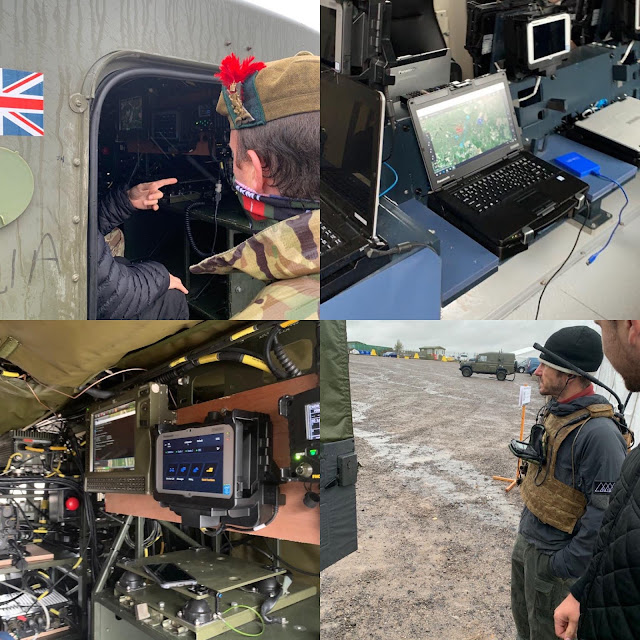British Army new strategy places focus on cutting edge science and technology. Ground-breaking innovation will be at the heart of defence activity for generations, thanks to a bold new Science and Technology Strategy unveiled today by Defence Secretary Ben Wallace.
The Army Warfighting Experiment gives personnel the opportunity to test new and improved technologies for the next-generation of warfare.
The strategy was launched with Chief Scientific Adviser, Professor Dame Angela McLean, against a backdrop of futuristic autonomous military kit: from UAVs that can fit in the palm of a hand to crewless all-terrain surveillance vehicles commanded remotely from a Challenger II tank and the new AJAX vehicle demonstrating ‘human machine teaming’ with an unmanned all terrain buggy.
Building on the UK’s rich heritage in science and technology, this new strategy will focus on finding and funding the breakthroughs that will shape the future, and ensure the armed forces are equipped to meet tomorrow’s threats.
It will also have a renewed focus on data, including capture and curation, which will underpin research to identify threat trends and deliver generation-after-next military hardware.
In recent weeks, we’ve successfully demonstrated our Manned Unmanned-Teaming (MUM-T) solution using ATHENA (an AJAX Family Variant), our 6x6 MUTT Unmanned Ground Vehicle (UGV) and an optionally-tethered Unmanned Air System (UAS) on Salisbury Plain… #AWE19 @BritishAWE @dstlmod pic.twitter.com/yTBWRtpmPJ
— General Dynamics UK (@gduknews) October 20, 2020
Defence Secretary Ben Wallace said:
We are in a very real race with our adversaries for technological advantage. What we do today will lay the groundwork for decades to come. Proliferation of new technologies demands our science and technology is threat driven and better aligned to our needs in the future.
The pair visited Salisbury Plain ahead of the Army Warfighting Experiment (AWE), which this week will showcase some of the latest British-built military technologies.
Professor Dame Angela McLean said:
We need a clear focus on what we want science and technology to achieve. I will champion a challenge-led approach, based on trends across science, technology and the military, to set out what we need to be able to do in the future and how we can build towards it through our S&T activity.
Minister for Science Research and Innovation Amanda Solloway said:
Placing science and research at the heart of the UK’s defence activity will unleash a new wave of innovation for our brilliant armed forces, equipping them to meet our greatest challenges. By backing our best and brightest scientific minds in every corner of the UK, we will ensure we bolster the security of our nation now and for decades to come.
The Army Warfighting Experiment series allows the British Army to push the boundaries of technology and military technology, testing a range of prototype systems by putting them in the hands of the user while giving invaluable feedback to suppliers. This is all done to ensure that British troops maintain a continuous advantage over adversaries on the battlefield of today and tomorrow.
This complements the ongoing Integrated Review of foreign, defence, development and security policy. The Strategy & Technology will also be central to the government’s ambition for the UK to cement its status as a world leading science superpower, set out in its ambitious Research & Development Roadmap in July this year.
The latest strategy launch comes weeks after the MoD rolled out a new integrated operational concept to shape how Britain adapts its future military effort to the changing security threat posed by the likes of China and Russia.
Future military development would focus on five emerging technology areas that have posed the most significant enduring capability challenge, according to the new S&T strategy document. Technology areas listed are:
- Pervasive, full-spectrum, multidomain intelligence, surveillance and reconnaissance.
- Multidomain command and control, communications, and computers.
- Improvement of the U.K.’s ability to compete against adversaries below the threshold of conventional conflict while addressing vulnerabilities, especially in the information environment.
- Develop systems to target adversaries in new ways across all domains.
- Generate affordable, survivable capabilities that can rapidly address evolving threats and can operate within a denied electromagnetic environment.
- “They have been recognized as the key drivers for science and technology and research and development within the MoD," the document read. "The Department will continue to have an enduring requirement to maintain investment in science and technology capabilities and programs beyond these.”
Photo credit Defence Photography







No comments:
Post a Comment